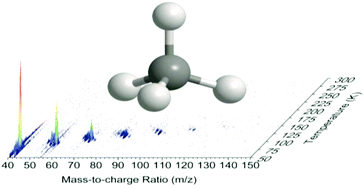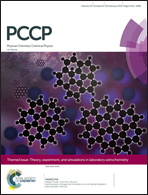Untangling the methane chemistry in interstellar and solar system ices toward ionizing radiation: a combined infrared and reflectron time-of-flight analysis†
Abstract
Pure methane (CH4/CD4) ices were exposed to three ionizing radiation sources at 5.5 K under ultrahigh vacuum conditions to compare the complex hydrocarbon spectrum produced across several interstellar environments. These irradiation sources consisted of energetic electrons to simulate secondary electrons formed in the track of galactic cosmic rays (GCRs), Lyman α (10.2 eV; 121.6 nm) photons simulated the internal VUV field in a dense cloud, and broadband (112.7–169.8 nm; 11.0–7.3 eV) photons which mimic the interstellar ultra-violet field. The in situ chemical evolution of the ices was monitored via Fourier transform infrared spectroscopy (FTIR) and during heating via mass spectrometry utilizing a quadrupole mass spectrometer with an electron impact ionization source (EI-QMS) and a reflectron time-of-flight mass spectrometer with a photoionization source (PI-ReTOF-MS). The FTIR analysis detected six small hydrocarbon products from the three different irradiation sources: propane [C3H8(C3D8)], ethane [C2H6(C2D6)], the ethyl radical [C2H5(C2D5)], ethylene [C2H4(C2D4)], acetylene [C2H2(C2D2)], and the methyl radical [CH3(CD3)]. The sensitive PI-ReTOF-MS analysis identified a complex array of products with different products being detected between experiments with general formulae: CnH2n+2 (n = 4–8), CnH2n (n = 3–9), CnH2n−2 (n = 3–9), CnH2n−4 (n = 4–9), and CnH2n−6 (n = 6–7) from electron irradiation and CnH2n+2 (n = 4–8), CnH2n (n = 3–10), CnH2n−2 (n = 3–11), CnH2n−4 (n = 4–11), CnH2n−6 (n = 5–11), and CnH2n−8 (n = 6–11) from broadband photolysis and Lyman α photolysis. These experiments show that even the simplest hydrocarbon can produce important complex hydrocarbons such as C3H4 and C4H6 isomers. Distinct isomers from these groups have been shown to be important reactants in the synthesis of polycyclic aromatic hydrocarbons like indene (C9H8) and naphthalene (C10H8) under interstellar conditions.

- This article is part of the themed collection: Theory, experiment, and simulations in laboratory astrochemistry


 Please wait while we load your content...
Please wait while we load your content...